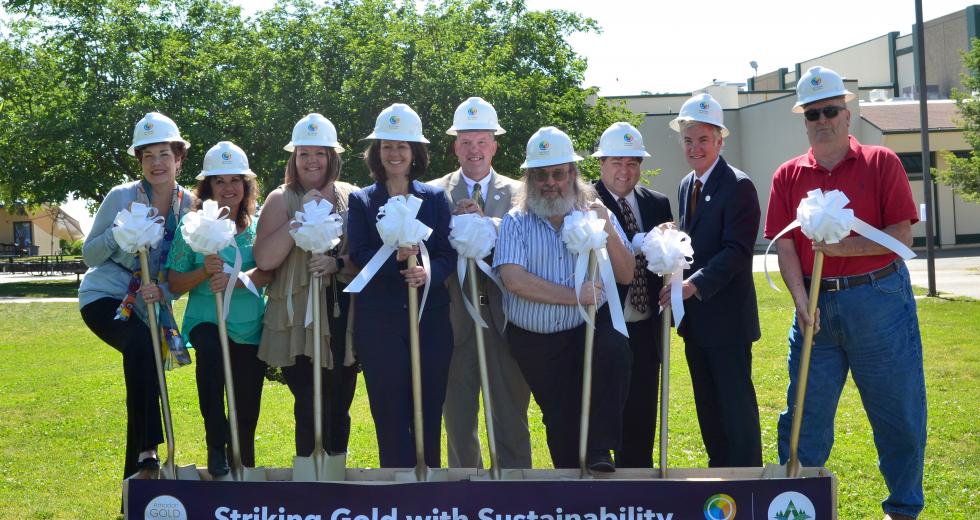Under sunny skies at Argonaut High School in Jackson, representatives from the Amador County Public Schools system and OpTerra Energy Services recently celebrated the official groundbreaking of the Amador GOLD program. The public-private partnership combines school infrastructure improvement and energy-efficiency projects with STEM education for students.
The infrastructure improvements include installation of solar-panelled shade structures at Amador High School in Sutter Creek and Argonaut High School, LED lighting fixture upgrades across 14 campuses and replacement of 95 outdated HVAC systems throughout the 15-school district. According to project specifications, these updates are expected to save the district more than $17 million over the next 20 years, eliminate 2,179 metric tons of carbon dioxide emissions annually and bring an estimated 57 jobs to the rural community.
The school board approved the project in December 2016, and Superintendent Amy Slavensky has been working to make it a reality since joining the district last October.
Slavensky says what excites her most about the project is how it will improve both the instruction and learning environments of students. The educational component of the partnership will include opportunities and programs designed and led by the OpTerra team, including an on-campus professional development program, STEM-focused lesson planning resources for teachers, hands-on career exposure for middle and high school students, a STEM Summer Institute and internships at OpTerra for the district’s high school students.
“The focus on science, technology, engineering and math instruction is significant,” Slavensky says. “It’s going to be very beneficial for our students immediately and then over the years as well.”
Teachers and staff have been receiving training that will help them implement the new STEM-focused curriculum, continue to meet Common Core standards and adopt the newer Next Generation Science Standards, which focus on improving science education for students across the U.S.
While the district’s past was not a topic of discussion at the event, the program is evidence of the community’s hope to put the focus back on education after a problematic year — one that included the July 2016 resignation of former superintendent Elizabeth Chapin-Pinotti, who was faced with several felony charges involving fraud, perjury and forgery, and an Amador County Grand Jury Report released in June 2016 that alleged incidents of intimidation and unprofessional behavior among school board trustees in the Amador County Unified School District and Office of Education.
Related: Making the Grade
From the stage at the groundbreaking event in May, California State Superintendent of Public Instruction Tom Torlakson noted that public-private projects like Amador GOLD are an example of what’s possible. “I count it as a four-way win,” he says. “One, because it’s a budget win at $17 million — that means something in tight times. No. 2, it’s a huge educational opportunity. Three, it’s the jobs that are created that help strengthen our economy. And it’s also helping planet earth.”
The OpTerra team worked collaboratively with the district, and according to OpTerra Program Development Manager Carolyn Kiesner, the project’s sustainability factor — on both an energy and financial front — was important. “We always start our projects with a high-level energy analysis and feasibility study and once we did that … they saw how much they’re spending on their utility bills,” she says.
Kiesner adds that Amador County voters tend to be conservative when it comes to passing local tax increases and bond measures, so, “If you’re in a more conservative county that doesn’t want to pass a bond tax, that leaves the school with a lot of needs,” she says. “So it was just a really smart project in terms of the financing.”
The project is being funded through a combination of sources, including $3.3 million from Proposition 39 (known as the California Clean Energy Jobs Act), $3.8 million in IRS Subsidized Certified Renewable Energy Bonds and a tax-exempt lease purchase agreement, which is used in these situations as an alternative to traditional financing options. Kiesner also notes that school district will likely see additional savings over time that could be used for a deferred maintenance program, which is something the district currently doesn’t have.
Slavensky is eager to keep the momentum moving forward with the project. While the groundbreaking ceremony was largely ceremonial, both the construction and educational sides of the program are already underway.
In an interview after the groundbreaking ceremony, Torlakson spoke to the uniqueness of this program and the entities involved, as they’ve had to make this project pencil without going directly to the voters. “Most of the [projects] I’m aware of are in urban areas and they have deeper resources, so for this school district and this county office of education to work so well together and bring this to fruition is a testimony to their skill and leadership,” he says. “One of the things I’ve been impressed with is how involved the community is with supporting their schools. The smaller rural districts have leaders who really care and the community pitches in.”



